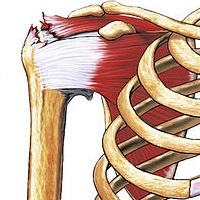
Photo from wikipedia
Background: Underlying muscle weakness and stiffness may increase the risk of developing rotator cuff tendinopathy. This systematic review aims to assess existing prospective studies to summarize whether muscle weakness and… Click to show full abstract
Background: Underlying muscle weakness and stiffness may increase the risk of developing rotator cuff tendinopathy. This systematic review aims to assess existing prospective studies to summarize whether muscle weakness and stiffness are risk factors for the development of rotator cuff tendinopathy in overhead athletes. Methods: A systematic search was performed using PRISMA guidelines. Prospective studies measuring muscle strength or stiffness and the incidence of rotator cuff tendinopathy were included. Quality assessment was performed with the Newcastle-Ottawa quality assessment scale. Results: The search yielded six studies, with a total of 523 trained overhead athletes followed up for one season. External rotation (ER) and internal rotation (IR) strength were described as protective factors against the development of rotator cuff tendinopathy. Athletes who did not sustain shoulder injuries had statistically stronger eccentric IR (p < 0.01) and ER (p < 0.05) strength in the pre-season assessment. Muscle stiffness indicated by limited range of motion of <106° for shoulder ER was described as a risk factor with an odds ratio of 1.12 (p < 0.001). Imbalance between ER and IR strength was reported as risk factors for shoulder injuries in two studies, with a relative risk of 2.57 (p < 0.05) reported in one study. Supraspinatus weakness was also reported as a risk factor for shoulder injuries in one study. Conclusion: Limited evidence support ER, IR weakness, limited ER range of motion, and very limited evidence support imbalance in ER/IR strength, and supraspinatus weakness as risk factors for rotator cuff tendinopathy in overhead athletes. No existing studies investigated the general population on this topic. Future cohort studies may improve on existing evidence with investigations on the general public, a longer follow-up time, clearly documented injury history, and a stringent diagnosis to rotator cuff tendinopathy.
Journal Title: Therapeutic Advances in Chronic Disease
Year Published: 2021
Link to full text (if available)
Share on Social Media: Sign Up to like & get
recommendations!